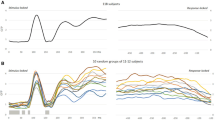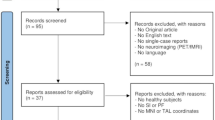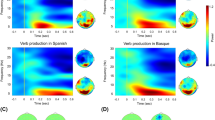Abstract
Picture naming tasks are largely used to elicit the production of specific words and sentences in psycholinguistic and neuroimaging research. However, the generation of lexical concepts from a visual input is clearly not the exclusive way speech production is triggered. In inferential speech encoding, the concept is not provided from a visual input, but is elaborated though semantic and/or episodic associations. It is therefore likely that the cognitive operations leading to lexical selection and word encoding are different in inferential and referential expressive language. In particular, in picture naming lexical selection might ensue from a simple association between a perceptual visual representation and a word with minimal semantic processes, whereas richer semantic associations are involved in lexical retrieval in inferential situations. Here we address this hypothesis by analyzing ERP correlates during word production in a referential and an inferential task. The participants produced the same words elicited from pictures or from short written definitions. The two tasks displayed similar electrophysiological patterns only in the time-period preceding the verbal response. In the stimulus-locked ERPs waveform amplitudes and periods of stable global electrophysiological patterns differed across tasks after the P100 component and until 400–500 ms, suggesting the involvement of different, task-specific neural networks. Based on the analysis of the time-windows affected by specific semantic and lexical variables in each task, we conclude that lexical selection is underpinned by a different set of conceptual and brain processes, with semantic processes clearly preceding word retrieval in naming from definition whereas the semantic information is enriched in parallel with word retrieval in picture naming.



Similar content being viewed by others
References
Abdel Rahman R, Sommer W (2003) Does phonological encoding in speech production always follow the retrieval of semantic knowledge? Electrophysiological evidence for parallel processing. Brain Res Cogn Brain Res 16:372–382
Alario FX, Ferrand L (1999) A set of 400 pictures standardized for French: norms for name agreement, image agreement, familiarity, visual complexity, image variability, and age of acquisition. Behav Res Methods Instrum Comput 31:531–552
Alario FX, Ferrand L, Laganaro M et al (2004) Predictors of picture naming speed. Behav Res Methods Instrum Comput 36:140–155
Baayen RH, Davidson DJ, Bates DM (2008) Mixed-effects modeling with crossed random effects for subjects and items. J Mem Lang 59:390–412. doi:10.1016/j.jml.2007.12.005
Bates D, Maechler M, Bolker B, Walker S (2014) lme4: linear mixed-effects models using eigen and S4. R package version 1.0-6. http://CRAN.R-project.org/package=lme4
Bell BD, Seidenberg M, Hermann BP, Douville K (2003) Visual and auditory naming in patients with left or bilateral temporal lobe epilepsy. Epilepsy Res 55:29–37
Bonin P, Chalard M, Méot A, Barry C (2006) Are age-of-acquisition effects on object naming due simply to differences in object recognition? Comments on levelt (2002). Mem Cognit 34(5):1172–1182
Brennen T, David D, Fluchaire I, Pellat J (1996) Naming faces and objects without comprehension: a case study. Cogn Neuropsychol 13:93–110
Brown AS (1991) A review of the tip-of-the-tongue experience. Psychol Bull 109:204–223
Brunet D, Murray MM, Michel CM (2011) Spatiotemporal analysis of multichannel EEG: CARTOOL. Comput Intell Neurosci. doi:10.1155/2011/813870
Burke DM, MacKay DG, Worthley JS, Wade E (1991) On the tip of the tongue: What causes word finding failures in young and older adults? J Mem Lang 30:542–579. doi:10.1016/0749-596X(91)90026-G
Caramazza A, Miozzo M (1997) The relation between syntactic and phonological knowledge in lexical access: evidence from the “tip-of-the-tongue” phenomenon. Cognition 64:309–343
Chalard M, Bonin P (2006) Age-of-acquisition effects in picture naming: Are they structural and/or semantic in nature? Vis Cognit 13(7–8):864–883
Changeux J-P, Michel CM (2004) Mechanisms of neural integration at the brain scale level: the neuronal workspace and microstate models. In: Grillner S, Grabyel AM (eds) Microcircuits: the interface between neurons and global brain function. The MIT Press, Cambridge, pp 347–370
Cheng X, Schafer G, Akyürek EG (2010) Name agreement in picture naming: an ERP study. Int J Psychophysiol 76:130–141. doi:10.1016/j.ijpsycho.2010.03.003
Cree GS, McRae K (2003) Analyzing the factors underlying the structure and computation of the meaning of chipmunk, cherry, chisel, cheese, and cello (and many other such concrete nouns). J Exp Psychol Gen 132:163–201
Damasio H, Grabowski TJ, Tranel D et al (1996) A neural basis for lexical retrieval. Nature 380:499–505
Dell GS (1986) A spreading-activation theory of retrieval in sentence production. Psychol Rev 93:283–321
Dhooge E, Hartsuiker RJ (2010) The distractor frequency effect in picture-word interference: evidence for response exclusion. J Exp Psychol Learn Mem Cogn 36:878–891. doi:10.1037/a0019128
Fargier R, Laganaro M (2015) Neural dynamics of object noun, action verb and action noun production in picture naming. Brain Lang 150:129–142. doi:10.1016/j.bandl.2015.09.004
Glaser WR (1992) Picture naming. Cognition 42:61–105
Goldstein H (1987) Multilevel covariance component models. Biometrika 74:430–431. doi:10.1093/biomet/74.2.430
Goldstein H (1995) Multilevel statistical models. Arnold, London
Hamberger MJ, Seidel WT (2003) Auditory and visual naming tests: normative and patient data for accuracy, response time, and tip-of-the-tongue. J Int Neuropsychol Soc JINS 9:479–489
Heilman KM, Tucker DM, Valenstein E (1976) A case of mixed transcortical aphasia with intact naming. Brain J Neurol 99:415–426
Indefrey P (2011) The spatial and temporal signatures of word production components: a critical update. Front Psychol 2:255. doi:10.3389/fpsyg.2011.00255
Indefrey P (2016) On putative shortcomings and dangerous future avenues: response to Strijkers & Costa. Lang Cogn Neurosci. doi:10.1080/23273798.2015.1128554
Indefrey P, Levelt WJM (2004) The spatial and temporal signatures of word production components. Cognition 92(1–2):101–144. doi:10.1016/j.cognition.2002.06.001
Johnson CJ, Paivio A, Clark JM (1996) Cognitive components of picture naming. Psychol Bull 120:113–139
Kiefer M (2001) Perceptual and semantic sources of category-specific effects: event-related potentials during picture and word categorization. Mem Cognit 29:100–116
Kittredge AK, Dell GS, Verkuilen J, Schwartz MF (2008) Where is the effect of frequency in word production? Insights from aphasic picture-naming errors. Cogn Neuropsychol 25:463–492. doi:10.1080/02643290701674851
Koenig T, Stein M, Grieder M, Kottlow M (2014) A tutorial on data-driven methods for statistically assessing ERP topographies. Brain Topogr 27:72–83. doi:10.1007/s10548-013-0310-1
Koukkou M, Lehmann D (1987) An information-processing perspective of psychophysiological measurements. J Psychophysiol 1:109–112
Kremin H (1986) Spared naming without comprehension. J Neurolinguistics 2:131–150
Kremin H (1988) Independence of access to meaning and to phonology: Arguments for direct non-semantic pathways for the naming of written words and pictures. In: Perspectives on cognitive neuropsychology, Lawrence Erlbaum. London, pp 231–252
Laganaro M, Perret C (2011) Comparing electrophysiological correlates of word production in immediate and delayed naming through the analysis of word age of acquisition effects. Brain Topogr 24:19–29. doi:10.1007/s10548-010-0162-x
Lehmann D, Skrandies W (1980) Reference-free identification of components of checkerboard-evoked multichannel potential fields. Electroencephalogr Clin Neurophysiol 48:609–621
Lehmann D, Strik WK, Henggeler B, Koenig T, Koukkou M (1998) Brain electric microstates and momentary conscious mind states as building blocks of spontaneous thinking: I. Visual imagery and abstract thoughts. Int J Psychophysiol 29:1–11
Levelt WJ, Roelofs A, Meyer AS (1999) A theory of lexical access in speech production. Behav Brain Sci 22:1–38 (discussion 38–75)
Mahon BZ, Navarrete E (2016) Modelling lexical access in speech production as a ballistic process. Lang Cogn Neurosci. doi:10.1080/23273798.2015.1129060
Marconi D (1997) Lexical competence. MIT Press, Cambridge
Marconi D, Manenti R, Catricalà E et al (2013) The neural substrates of inferential and referential semantic processing. Cortex 49:2055–2066. doi:10.1016/j.cortex.2012.08.001
Maris E, Oostenveld R (2007) Nonparametric statistical testing of EEG- and MEG-data. J Neurosci Methods 164:177–190
Martin A, Chao LL (2001) Semantic memory and the brain: structure and processes. Curr Opin Neurobiol 11:194–201
Michel CM, Murray MM (2012) Towards the utilization of EEG as a brain imaging tool. NeuroImage 61:371–385. doi:10.1016/j.neuroimage.2011.12.039
Michel CM, Koenig T, Brandeis D, Gianotti LRR (2009) Electric neuroimaging. Cambridge University Press, Cambridge
Miozzo M, Pulvermuller F, Hauk O (2015) Early parallel activation of semantics and phonology in picture naming: evidence from a multiple linear regression MEG Study. Cereb Cortex 25(10):3343–3355
Morrison CM, Ellis AW (1995) The roles of word frequency and age of acquisition in word naming and lexical decision. J Exp Psychol Learn Mem Cogn 21:116–133
Morrison CM, Ellis AW, Quinlan PT (1992) Age of acquisition, not word frequencw, affects object naming, not object recognition. Mem Cognit 20:705–714
Munding D, Dubarry AS, Alario FX (2016) On the cortical dynamics of word production: a review of the MEG evidence. Lang Cogn Neurosci. doi:10.1080/23273798.2015.107185
Murray MM, Brunet D, Michel CM (2008) Topographic ERP analyses: a step-by-step tutorial review. Brain Topogr 20:249–264. doi:10.1007/s10548-008-0054-5
New B, Pallier C, Brysbaert M, Ferrand L (2004) Lexique 2: a new French lexical database. Behav Res Methods Instrum Comput 36:516–524
Oostenveld R, Fries P, Maris E, Schoffelen J-M (2011) FieldTrip: open source software for advanced analysis of MEG, EEG, and invasive electrophysiological data. Comput Intell Neurosci. doi:10.1155/2011/156869
Pascual-Marqui RD, Michel CM, Lehmann D (1995) Segmentation of brain electrical activity into microstates: model estimation and validation. IEEE Trans Biomed Eng 42:658–665. doi:10.1109/10.391164
Paz-Caballero D, Cuetos F, Dobarro A (2006) Electrophysiological evidence for a natural/artifactual dissociation. Brain Res 1067:189–200. doi:10.1016/j.brainres.2005.10.046
Perret C, Bonin P, Laganaro M (2014) Exploring the multiple-level hypothesis of AoA effects in spoken and written object naming using a topographic ERP analysis. Brain Lang 135:20–31. doi:10.1016/j.bandl.2014.04.006
Perrin F, Pernier J, Bertrand O et al (1987) Mapping of scalp potentials by surface spline interpolation. Electroencephalogr Clin Neurophysiol 66:75–81
Poch C, Garrido MI, Igoa JM et al (2015) Time-varying effective connectivity during visual object naming as a function of semantic demands. J Neurosci Off J Soc Neurosci 35:8768–8776. doi:10.1523/JNEUROSCI.4888-14.2015
Protopapas A (2007) CheckVocal: a program to facilitate checking the accuracy and response time of vocal responses from DMDX. Behav Res Methods 39:859–862
Race DS, Tsapkini K, Crinion J et al (2013) An area essential for linking word meanings to word forms: evidence from primary progressive aphasia. Brain Lang 127:167–176. doi:10.1016/j.bandl.2013.09.004
Sartori G, Lombardi L (2004) Semantic relevance and semantic disorders. J Cogn Neurosci 16:439–452. doi:10.1162/089892904322926773
Schendan HE, Maher SM (2009) Object knowledge during entry-level categorization is activated and modified by implicit memory after 200 ms. NeuroImage 44:1423–1438. doi:10.1016/j.neuroimage.2008.09.061
Schmitt BM, Münte TF, Kutas M (2000) Electrophysiological estimates of the time course of semantic and phonological encoding during implicit picture naming. Psychophysiology 37:473–484
Silveri MC, Colosimo C (1995) Hypothesis on the nature of comprehension deficit in a patient with transcortical mixed aphasia with preserved naming. Brain Lang 49:1–26. doi:10.1006/brln.1995.1019
Strijkers K, Costa A, Thierry G (2010) Tracking lexical access in speech production: electrophysiological correlates of word frequency and cognate effects. Cereb Cortex N Y N 20:912–928. doi:10.1093/cercor/bhp153
Strijkers K, Costa A (2016) On words and brains: linking psycholinguistics with neural dynamics in speech production. Lang Cogn Neurosci. doi:10.1080/23273798.2016.1158845
Thorpe SJ (2009) The speed of categorization in the human visual system. Neuron 62:168–170. doi:10.1016/j.neuron.2009.04.012
Thorpe S, Fize D, Marlot C (1996) Speed of processing in the human visual system. Nature 381:520–522. doi:10.1038/381520a0
Trebuchon-Da Fonseca A, Guedj E, Alario F-X et al (2009) Brain regions underlying word finding difficulties in temporal lobe epilepsy. Brain J Neurol 132:2772–2784. doi:10.1093/brain/awp083
Valente A, Bürki A, Laganaro M (2014) ERP correlates of word production predictors in picture naming: a trial by trial multiple regression analysis from stimulus onset to response. Front Neurosci 8:390. doi:10.3389/fnins.2014.00390
Warrington EK, Shallice T (1984) Category specific semantic impairments. Brain J Neurol 107(Pt 3):829–854
Wheeldon L, Levelt WJM (1995) Monitoring the time course of phonological encoding. J Mem Lang 34:311–334
Wu C-T, Crouzet SM, Thorpe SJ, Fabre-Thorpe M (2015) At 120 msec you can spot the animal but you don’t yet know it’s a dog. J Cogn Neurosci 27:141–149. doi:10.1162/jocn_a_00701
Yaniv I, Meyer DE (1987) Activation and metacognition of inaccessible stored information: potential bases for incubation effects in problem solving. J Exp Psychol Learn Mem Cogn 13:187–205
Zhang Q, Damian MF (2009) The time course of semantic and orthographic encoding in Chinese word production: an event-related potential study. Brain Res 1273:92–105. doi:10.1016/j.brainres.2009.03.049
Acknowledgments
This research was supported by Swiss National Science Foundation Grant No. 105319_146113.
Author information
Authors and Affiliations
Corresponding author
Electronic supplementary material
Below is the link to the electronic supplementary material.
Appendix
Appendix
Rights and permissions
About this article
Cite this article
Fargier, R., Laganaro, M. Spatio-temporal Dynamics of Referential and Inferential Naming: Different Brain and Cognitive Operations to Lexical Selection. Brain Topogr 30, 182–197 (2017). https://doi.org/10.1007/s10548-016-0504-4
Received:
Accepted:
Published:
Issue Date:
DOI: https://doi.org/10.1007/s10548-016-0504-4




